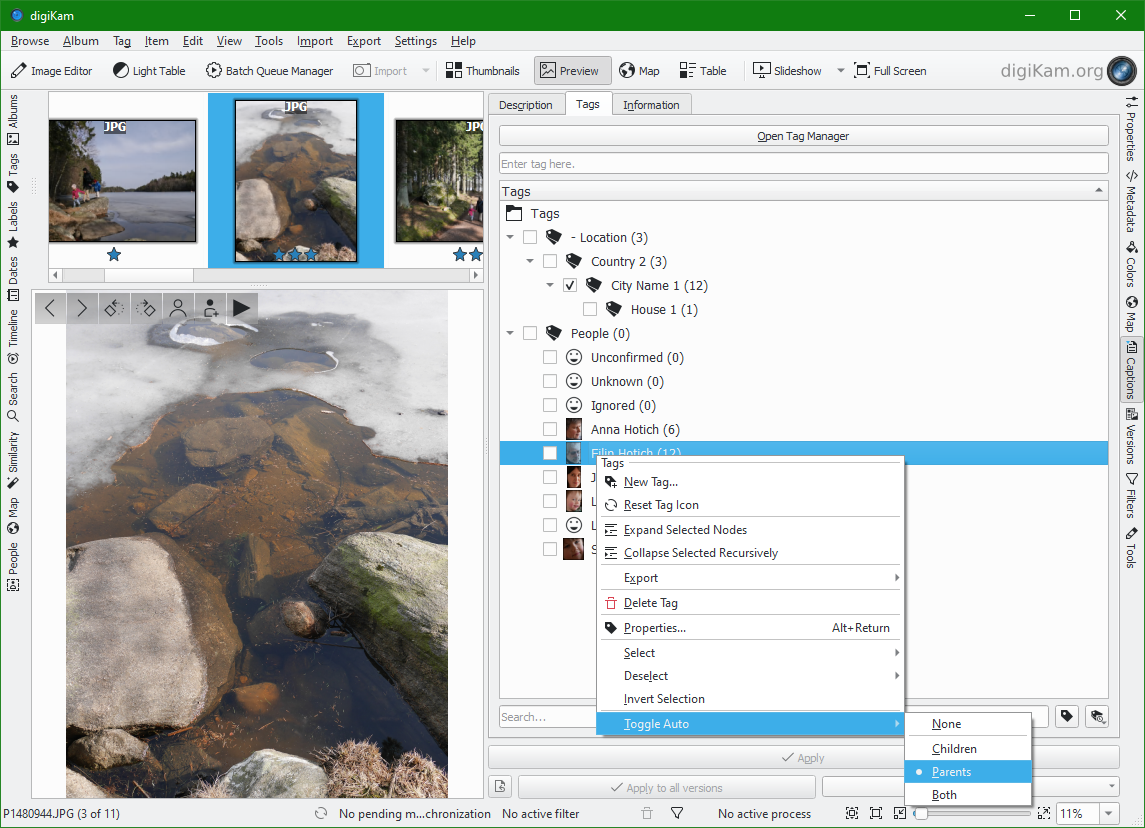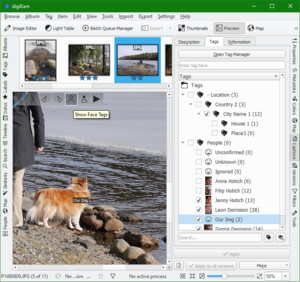Digikam/Tutorials/Tagging and Face Tags
What is Tagging and why do you want it
digiKam is an excellent tool to enrich a private photo collection by use of Tags and other metadata that can be written right inside the image files so the information you add follows the image file and will not get lost if you change computers or software (alternatively digiKam can save metadata in "sidecar" helper files next to your videos or read-only image files).
Tags in your photo collection work the same as #hashtags on the Internet – they help you to find all your images that belong to the same category that you provided: locations, names of people, events (birthday, national day…) or anything that is meaningful to you (for example pictures that contain Lego; your 2nd car; sunsets; etc.).
In addition you can mark specific regions on the picture as “Face tags”, add descriptive text, rating from 1 to 5 stars and some more metadata types. All of this needs to be worth-it – add data that you will realistically want to search and filter your collection on. Plus remember that you already have photo date, folder name where the photos are located (which is hopefully meaningful) and possibly even geographical coordinates embedded in your image files even before you start adding any tags.
Working with Tags can be as simple as marking location, who is in the picture and giving 4-5 stars to really nice pictures. Perhaps you will see an existing Tag hierarchy in your digiKam that was built based on Tags that were found in the images that you already have (those tags may come from your relative, friend or even some software and you are free to use those tags as an example or build your own system). On the other extreme metadata can get almost scientific with rules, data models and words like “Digital Asset Management”. When you are ready to try adding some tags, continue with this tutorial on How to do it.
Recently machine learning "AI" algorithms are doing more and more photo classification fully automatically, without any manual Tagging needed. Still you can decide yourself how much manual tagging is worth it and what can be guessed by an algorithm. Note that digiKam also includes some similarity search tools and other clever algorithms which will evolve in the future to provide more value and easier search in your private photo collection.
Main Tagging tools in digiKam
In the current version of digiKam (7.2+) it can be a little bit complicated to find all the metadata tools and toolbars, but thankfully there are excellent keyboard shortcuts that will both help you find all the necessary toolbars and also make entering information very efficient if you choose to remember the shortcuts.
- The main metadata tools
| Tags: | T (re-configurable) |
| Face Tags or people tags: | Ctrl + drag a box around a face |
| Star rating: | Ctrl + 0 … Ctrl + 5 (re-configurable) |
| Edit Comment: | Alt + Shift + C (re-configurable) |
| Edit Title: | Alt + Shift + T (re-configurable) |
| Pick Label (flag) | Alt + 0 … Alt + 3 (re-configurable) |
| Color Label: | Ctrl + Alt + 0 … Ctrl + Alt + 9 (re-configurable) |
| Edit Geo location: | Ctrl + Shift + G (re-configurable) |
| Edit Metadata (lots of fields): | Ctrl + Shift + M (re-configurable) |
+ There are more tools such as “Adjust Time & Date” – see the menus and keyboard shortcuts.
Tags – How To
To add a Tag – just press T when you have a picture selected. This will immediately open the right toolbar and you can start typing in a tag. Auto-complete will help you find the right spelling to match existing tags, or you can define a new tag.
When the “Tags” tab is open you can also add/remove tags by using mouse.

Organize tags:
- Build/edit tag hierarchy (good idea!) - you can drag and drop tags onto each other to “Move here” and create tags and sub-tags. For example Place “Family X home” under “City Name” to get a basic hierarchy.
- Rename tags – right click any tag and select and edit tag “Title”.
- Delete tags – note, if you Delete a tag, it will be removed from all files that ever used it!
- Assign keyboard shortcut to a Tag – it is possible to add a unique shortcut key to directly assign frequently used tags.
- Changing icon – each tag can have a custom icon (the icon will not be valid outside your digiKam, so do not spend too much effort on this).
digiKam will propagate the change across all image files that used the old name.
Face Tags – How To
Face or People tags are excellent to show not only who is in the picture but also which one out of all those wedding guests is that person you are looking for. Note that digiKam is unique among open-source and multi-patform photo galleries to feature full support for face regions (including imported face tags from other software) – as always digiKam saves your efforts into formats that will be readable by other software and the data stays safely embedded in each image file.
Automatic face detection module in DigiKam is working and being actively developed. It can help you tag people without any privacy concerns of the “free cloud services” such as Google or Facebook. The use of automatic face detection is outside of the scope of this tutorial, but it is highly recommended to use the automatic detection first and then compliment people tagging with manual face tagging.
For effective manual people-tagging use Ctrl + drag a box around a face shortcut. This is a must-know shortcut that beats any other method for adding face tags.

Comments, Captions Description and Title
You can use the “Captions” (and “Title”) field to write a text description about the photo or video which does not have the same limitations as the filename. I do NOT recommend to use both Title and Captions fields together as it may cause compatibility issues with other software, including loss of the contents for one of the fields. Shortcut to quickly find the field: Alt + Shift + C
Star rating
The classic 5-star rating feature. Quite widely supported and reasonably easy to interpret. You can find guides and suggestions how to use this scale or think of your own.
As an example, here is one way to interpret stars, as used by me:
| 0 stars | Not yet rated |
| 1 star | To Delete (not deleted for some reason) |
| 2 stars | Weak photo (useful for context, or completeness) |
| 3 stars | Good photo (nice to show to people) |
| 4 stars | Very good photo (“best of”) |
| 5 stars | Outstanding photo (“work of art”) |
Pick Label (flag) and Color Label
This type of labeling is quite individual and open for interpretation, so there is a risk that nobody except You will ever understand the meaning of your flags and colors. Still the feature is included in digiKam and will be written into the files.
Geo location
Geo-tags is a big topic with special tools that can help recording and adding GPS data to your image files. DigiKam supports Geo-tags and map view, but the exact workflow and limitations are outside the scope of this tutorial. shortcut: Ctrl + Shift + M.
Author, copyrights and other Metadata
If you wish to add other metadata, you are welcome to use “Edit Metadata” tool with a shortcut: Ctrl + Shift + M.
”The batch-click way” method for quicker tagging
Peter Albrecht described his digiKam tagging workflow with focus on efficiency that may help you gain speed and efficiency.
- switch to thumbnail view (you have to be able to select more than one image)
- shift the preview size to the maximum of 256 pixel (you want to be able to recognize the people on the photos)
- switch the right side-view to Caption/Tags (click the
 icon) and select the tab
icon) and select the tab - select picture number one and look at the leftmost person on this picture
- hold Ctrl down and select all other pictures, showing this person
- search for the corresponding tag in the right side-view, select it and apply.
- if there are more persons in picture one, then select this picture again go to step 5, while looking for the next leftmost person.
- if you have all the persons in picture one, select picture two and look again for the leftmost person, you have not tagged yet, and go to step 5. (toggling the button tags already assigned in the lower right corner of the Tags tab, is very useful here)
This way you go through all your pictures. In the beginning you have to tag a lot of people, but coming to the last pictures, most people will already be tagged and you can fast jump to the next picture.
About this tutorial
This tutorial is based on and is made to supersede the older tutorial from 2012: Tag your Photos (with focus on efficiency). You are very welcome to edit, update and Upgrade this tutorial page to make it better. No attribution or copyrights in this page!




